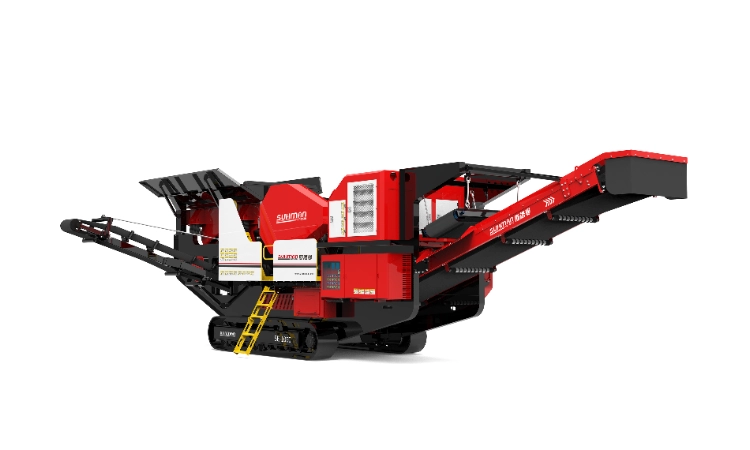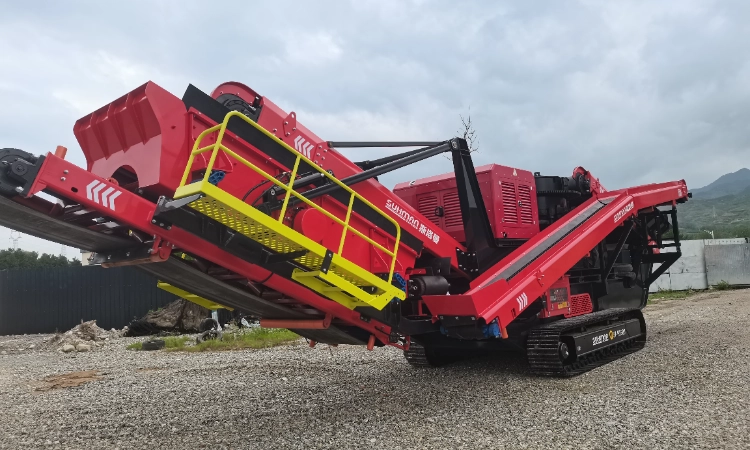What are the roles of each structural component in a mobile crushing station?
Release time: 2025-04-16
A mobile crushing station is a type of equipment that integrates feeding, crushing, screening, and conveying functions. It is widely used in mining, construction waste processing, road construction, and other fields. It adopts a modular design and is equipped with tires or tracks, enabling the mobile crushing station to quickly transfer between different sites, greatly improving operational flexibility and efficiency. The main components include the feeder, crusher, screening machine, conveyor, and power system.
Mobile Crushing Station
1. What roles do the structural components play in the mobile crushing station?
- Feeder: Its role is to uniformly and continuously feed the material to be crushed into the crusher. Types include vibrating feeders, plate feeders, etc.
- Crusher: Its role is to crush the material to achieve the required particle size. Types include jaw crushers, cone crushers, impact crushers, etc.
- Screening Machine: Its role is to screen the crushed material and separate products of different particle sizes. Types include vibrating screens, trommel screens, etc.
- Conveyor: Its role is to transport the material from one process to another or from the crushing station to a designated location. Types include belt conveyors, screw conveyors, etc.
- Power System: Its role is to provide power for the entire mobile crushing station. Types include diesel engines, electric motors, etc.
- Hydraulic System: Its role is to control the unfolding, folding, and height adjustment of the mobile crushing station, improving operational flexibility and safety. Types include hydraulic cylinders, hydraulic pumps, etc.
- Support System: Its role is to support the entire mobile crushing station, ensuring its stability and reliability during operation. Types include outriggers, hydraulic supports, etc.
- Tires/Tracks: Their role is to enable the crushing station to move between different sites, enhancing its flexibility. Types include rubber tires, steel tracks, etc.
2. Introduction to the convenience of transferring the mobile crushing station
- Modular Design: Features include independent disassembly and assembly of each functional module, facilitating transportation and assembly. Advantages are reduced transportation volume and weight, lowering transportation costs.
- Tire or Track Drive: Features include being equipped with tires or tracks, allowing self-movement between different sites. Advantages are no need for additional transportation equipment, improving transfer speed and flexibility.
- Quick Installation and Disassembly: Features include quick connection and locking devices, enabling rapid installation and disassembly. Advantages are shortened transfer time and improved work efficiency.
- Hydraulic Support System: Features include a hydraulic system for unfolding and folding the mobile crushing station, making it easy to operate. Advantages are reduced manual operation and improved safety.
- Compact Structure: Features include a compact overall structure, occupying little space. Advantages are ease of movement and operation in narrow or complex terrains.
- Flexible Configuration: Features include the ability to flexibly adjust and configure each module according to different operational needs. Advantages are strong adaptability, meeting the requirements of various working conditions.
If you want to know more about mobile crushing station equipment, please feel free to contact our online customer service. We will promptly answer your questions.
Supplementations and Enhancements
While the original text provides a clear and concise overview of mobile crushing stations, it lacks depth in certain areas such as technical advancements, specific applications, environmental benefits, safety features, maintenance requirements, and market trends. Below, I’ve supplemented the content to address these shortcomings and provide a more comprehensive understanding.
1. Technical Advancements
- Automation: Many modern mobile crushing stations feature advanced automation systems, such as PLC (Programmable Logic Controller) technology, enabling real-time monitoring and remote operation. This reduces labor costs and improves precision.
- Energy Efficiency: New models incorporate energy-saving technologies like variable frequency drives (VFDs), which adjust power usage based on demand, potentially reducing energy consumption by up to 20%.
- Example: The Sandvik QJ341 mobile jaw crusher includes an intelligent control system that optimizes crushing performance and minimizes fuel consumption.
2. Specific Applications
- Mining: Mobile crushing stations process ore directly at mining sites, reducing transportation costs and time. For instance, they can crush limestone or granite near the quarry for immediate use.
- Construction Waste Processing: These stations recycle materials like concrete and asphalt into aggregates. In urban projects, they process demolition waste on-site, supporting sustainable building practices.
- Road Construction: They produce high-quality aggregates for road bases on location, speeding up construction timelines. For example, a mobile crusher might supply gravel for a highway project directly from a nearby source.
3. Environmental Benefits
- Reduced Emissions: On-site processing cuts down on truck transport, lowering CO2 emissions. Some models also include dust suppression systems to minimize air pollution.
- Resource Conservation: By recycling construction waste, mobile crushing stations reduce the need for virgin materials. Up to 95% of debris can be reused as aggregates.
- Noise Control: Advanced designs feature noise-reducing technologies, making them suitable for urban environments.
4. Safety Features
- Emergency Systems: Equipped with emergency stop buttons and pull cords, these stations allow rapid shutdowns to protect operators.
- Overload Protection: Crushers include systems that detect and adjust for uncrushable materials, preventing damage and ensuring safety.
- Remote Operation: Operators can control the station from a safe distance using remote monitoring, reducing exposure to hazards.
5. Maintenance and Support
- Routine Maintenance: Regular checks on hydraulic fluids, wear parts (e.g., crusher jaws), and lubrication are essential for longevity.
- Spare Parts: Manufacturers like Metso and Kleemann offer extensive spare parts networks and online ordering for quick replacements.
- Training: Operators benefit from training programs on safe operation and troubleshooting, often provided by equipment suppliers.
6. Market Trends
- Growth: The mobile crushing station market is projected to grow at a CAGR of 5.8% through 2030, driven by infrastructure demand in regions like Asia-Pacific.
- Innovation: Future developments may include hybrid power systems (diesel-electric) and AI-driven predictive maintenance to enhance efficiency.
- Regulations: Stricter environmental laws, such as the EU’s Stage V standards, are encouraging the adoption of cleaner technologies.



